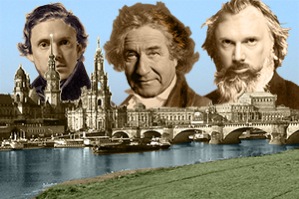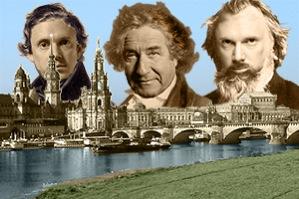This symphony orchestra is so old, Franz Schubert is one of the first violinists. Not the Franz Schubert, let me quickly add before you think Halloween ghosts. But if you were facing the Dresden Staatskapelle in Davies Symphony Hall on Sunday — an ensemble rated as one of the top five in Europe, with a 462-year-old pedigree, and it lays before you a Schuman-Beethoven-Brahms program right from their sweet spot in musical history — and you see that name in the list of personnel, you are bound to think: tradition. So what can be learned from experiencing their visit to our fair city? How does the group compare with our home team?

Illustration by Jeff Dunn
First point: The conductor isn’t German. Berlin-born Christian Thielemann doesn’t take over until 2012, so the Oxfordian Daniel Harding is guest conducting the U.S. tour. Nothing stiff and regimented about him: He has exceptionally fluid arm and wrist action with his small baton, so fluid he looked at times like he was dancing underwater. But this was only part of his repertoire: He could be resolute and energetic with equal aplomb when called for by the music. His interpretations of tempo and dynamics were mainstream, but he had a fine grasp of the big picture. This was best evidenced by his structuring of the Brahms Second Symphony. By holding back on climaxes for most of the evening (this includes those in Schumann’s Manfred Overture and Beethoven’s Fourth Piano Concerto), and then letting go at the Brahms finale, he made the can-be-stodgy-in-other-hands Johannes sound twice as exuberant as the music might have otherwise, generating thunderous and extended acclaim from the crowd. No encore, however.
But Harding wasn’t the only reason for the concert’s success. The Staatskapelle’s musicians present an impressively integrated and astutely balanced sound, characterized by a well-molded woodwind section capped by an ever-so-slightly amplified-above-normal trumpet top that helps greatly to clarify the doubled harmonies of the period. These special traits were most evident in the Schumann, for me the highlight of the evening. For one of the few times in my listening experience, Schumann’s orchestration sounded subtle, varied, even luminous.
Gentle Giant
The Beethoven concerto was performed by Rudolf Buchbinder, whose Commandatore-like presence, evoking the angry and disheveled cultural stereotype of the composer, belied the intriguing gentleness and restraint of his approach to the music. This low-keyed presentation was most effective in the second movement, where the contrast of the mild piano against stentorian strings was sharply etched. Where I would have appreciated a little more heft, however, was in the concluding Vivace. I like to hear more of a popping sound on the last note of the rondo melody, an effect that makes the normally consonant third of the scale sound surprisingly dissonant. Buchbinder’s note here sounded a bit lame to my taste.
Hearing this European orchestra was an instructive experience. The horns didn’t quite match the lush sound of the San Francisco Symphony’s, but they were more than adequate. Michael Tilson Thomas’ strings sound a little more edgy by comparison with those of the Dresden group, but as such they might be more effective in French and 20th-century repertoire. But I’ve never heard quite such a blend as the Staatskapelle conjured in the Schumann by any American orchestra. Having a less metronomic British conductor mellows out what may sound more rigid under other conductors. What will Thielemann bring to this illustrious orchestra? We’ll just have to wait till they come back to see us to find out.
(Incidentally, unlike American orchestras, which practice up a din on the stage before the concertmaster arrives for the official tuning, the Staatskapelliers filed on stage at once, silently, as a team. (See here for more on this issue. The Symphony’s new shrieking cell-phone warning announcement had no competition this time.)
All in all, German perfectionism and English fluidity made for a memorable combination. I could not help thinking of the smoothness of the Elbe as it flows under Dresden’s Augustus Bridge, a stone’s throw from the Staatskapelle’s home venue, the Semper Opera House. A perfect place to hear them do the Schubert Serenade, and hear two Schuberts in my ears.

